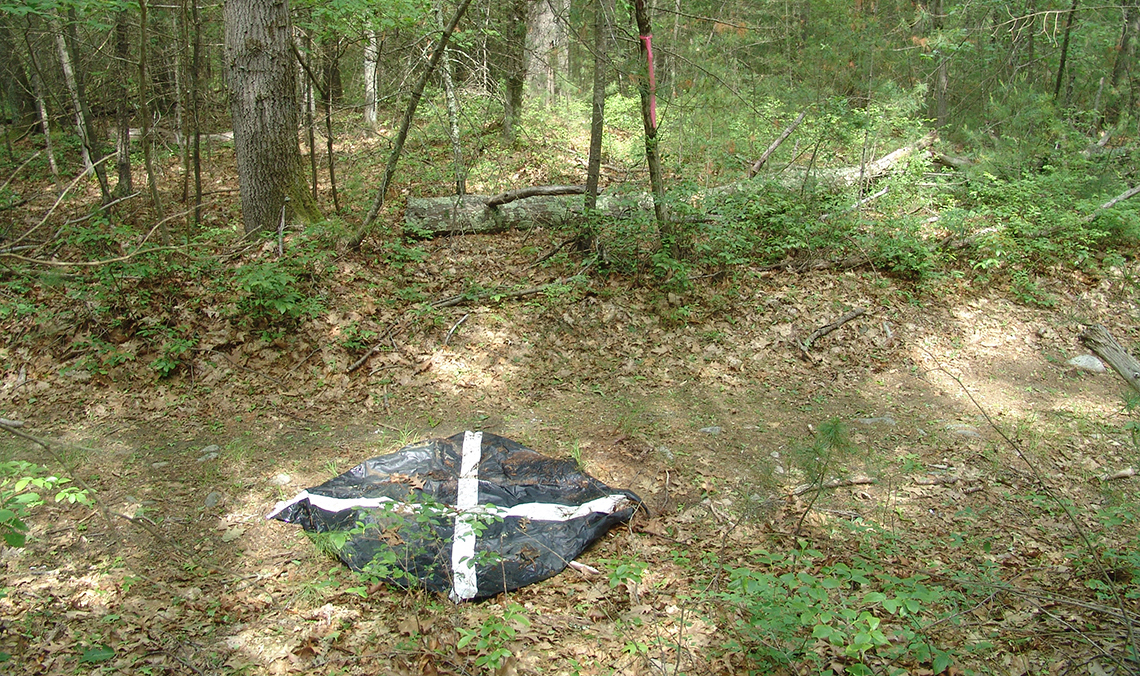By FRANK CARINI

Rhode
Island, with its slow response to addressing the siting of renewable energy,
has essentially marked forestland for solar development. (Frank Carini/ecoRI
News)
The
state of Rhode Island has gone to great lengths to protect 2 percent of its
trees from a tiny foreign invader, even as bulldozers plow through hundreds of
tree-covered acres unabated.
Efforts
by the Rhode Island Department of Environmental Management (DEM) to address the
destructive impacts of the emerald ash borer on the state’s ash trees are most
assuredly required and should be applauded.
However, a much bigger threat is wreaking havoc on Rhode Island’s forests at a far greater rate, and the state’s response has been molasses slow, inadequate, and shortsighted.
However, a much bigger threat is wreaking havoc on Rhode Island’s forests at a far greater rate, and the state’s response has been molasses slow, inadequate, and shortsighted.
The
preferred siting of solar energy on open space, most notably on forestland, is
a multilayered issue, but Rhode Island only seems to focuses on three points:
profit, tax revenue, and ridding the planet of fossil fuels.
The latter is a must, so money-grubbing opportunists, budget-challenged municipal officials, and a cranes-in-the-sky administration have crafted the argument that we need to clear-cut forests to protect the environment from the burning of fossil fuels.
The latter is a must, so money-grubbing opportunists, budget-challenged municipal officials, and a cranes-in-the-sky administration have crafted the argument that we need to clear-cut forests to protect the environment from the burning of fossil fuels.
This
circular logic is backstopped by two other arguments: the need to respect
property rights, although the parameters of that conversation would shift
dramatically if, say, a developer proposed Section 8 public housing, a
methadone clinic, or a composting operation rather than solar panels; and that
interconnection is too complex and substation upgrades too costly, so we must
sacrifice trees to keep private profits satisfactory.
Of course, the second argument would quickly disappear if taxpayers were to fund that complicated work.
Of course, the second argument would quickly disappear if taxpayers were to fund that complicated work.
As
Rhode Island’s open-space stampede enters its third year, the state continues
to delay any serious action, despite the fact hundreds of forested acres have
been cleared or are set to be cleared to make room for solar panels that could
also be sited on commercial rooftops, over parking lots, along medians, on
gravel pits, and on top of brownfields.
Although an exact number isn’t known, DEM has estimated that more than 10,000 brownfield sites are located in cities and towns across Rhode Island.
Some have already been remediated and reused, including a smattering for renewable-energy projects, thanks to conscientious developers and forward-thinking municipalities. But the woods remain the more popular destination for solar panels.
A
delay in updating siting standards benefits developers, and the state, led by
the Office of Energy Resources, has trotted out the old Rhode
Island standby: the call for endless study. In this case, two-plus years of
study and discussion haven’t yet determined that unnecessarily cutting down
forests, when plenty of developed space is available, makes no sense — it would
take a middle-school student less than a minute to come to that conclusion.
Unfortunately,
the state deploys the studying tool when it needs to make room for unfettered
economic development. This practice routinely has Rhode Island examining issues
from an upside-down point of view.
Even
though a seventh-grader understands that using developed areas first to site solar
arrays makes more sense environmentally and for future generations, reusing
already-damaged places isn’t as profitable or politically rewarding as setting
Paul Bunyan free.
In Rhode Island, building a 21st-century energy system the right way, with the least impact on our climate-stressed environment, takes a back seat to bottom lines and campaign promises.
In Rhode Island, building a 21st-century energy system the right way, with the least impact on our climate-stressed environment, takes a back seat to bottom lines and campaign promises.
The
future costs that come with degrading the environment by clear-cutting forests,
much like filling in wetlands and drowning salt marshes, to make room for
things that could be built somewhere else is someone else’s problem.
We’re
told that to build renewable-energy projects on landfills, brownfields, and on
other disturbed areas requires state and/or federal incentives, such as higher
rates for power, grants, and low-interest loans, to make those sites
financially viable.
Instead
of creating a system of stable incentives, developing an energy program that
makes the use of paved-over space and contaminated properties for solar and
wind development a priority, and requiring National Grid to map the state’s
grid capacity, accounting that includes environmental and public-health costs,
Rhode Island blindly rushes to reach an arbitrary renewable-energy goal.
In
March 2017, which, unsurprisingly, is when the solar-energy land rush began,
Gov. Gina Raimondo signed an unenforceable executive order that encouraged the
state to procure 1,000 megawatts of renewable energy by 2020. It essentially
incentivized the clear-cutting of woodlands.
The nonbinding order increased the number of renewable-energy applications being filed in cities and towns that hadn’t yet adopted regulations to address the impacts of this fast-growing industry.
The governor’s order didn’t bother to address the issue of siting. Municipalities, with limited guidance from the state, are still struggling to deal with the preponderance of applications looking to develop utility-scale energy projects on forestland and in neighborhoods.
DEM noted that its strategy
for eradicating the emerald ash borer is to focus on prevention, preparedness,
response, and recovery. The state agency and its partners, including National
Grid, are working with local communities, homeowners, and woodland property
owners to help them prepare for, manage, and recover from the invasive pest’s
impacts.
Too
bad Rhode Island doesn’t take other threats to its forestland as seriously.
Frank
Carini is the ecoRI News editor.